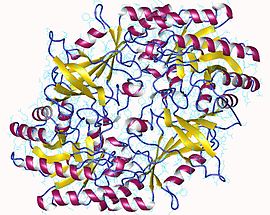| Ornithine decarboxylase | |||||||||
|---|---|---|---|---|---|---|---|---|---|
 Ornithine decarboxylase dimer, Human | |||||||||
| Identifiers | |||||||||
| EC no. | 4.1.1.17 | ||||||||
| CAS no. | 9024-60-6 | ||||||||
| Databases | |||||||||
| IntEnz | IntEnz view | ||||||||
| BRENDA | BRENDA entry | ||||||||
| ExPASy | NiceZyme view | ||||||||
| KEGG | KEGG entry | ||||||||
| MetaCyc | metabolic pathway | ||||||||
| PRIAM | profile | ||||||||
| PDB structures | RCSB PDB PDBe PDBsum | ||||||||
| Gene Ontology | AmiGO / QuickGO | ||||||||
| |||||||||
| ornithine decarboxylase | |||||||
|---|---|---|---|---|---|---|---|
| Identifiers | |||||||
| Symbol | ODC1 | ||||||
| NCBI gene | 4953 | ||||||
| HGNC | 8109 | ||||||
| OMIM | 165640 | ||||||
| RefSeq | NM_002539 | ||||||
| UniProt | P11926 | ||||||
| Other data | |||||||
| EC number | 4.1.1.17 | ||||||
| Locus | Chr. 2 p25 | ||||||
| |||||||
The enzyme ornithine decarboxylase (EC 4.1.1.17, ODC) catalyzes the decarboxylation of ornithine (a product of the urea cycle) to form putrescine. This reaction is the committed step in polyamine synthesis.[1] In humans, this protein has 461 amino acids and forms a homodimer.[2]
In humans, ornithine decarboxylase (ODC) is expressed by the gene ODC1. The protein ODC is sometimes referred to as "ODC1" in research pertaining to humans and mice, but certain species such as Drosophila (dODC2),[3] species of Solanaceae plant family (ODC2),[4] and the lactic acid bacteria Paucilactobacillus wasatchensis (odc2)[5] have been shown to have a second ODC gene.
- ^ Kern AD, Oliveira MA, Coffino P, Hackert ML (May 1999). "Structure of mammalian ornithine decarboxylase at 1.6 A resolution: stereochemical implications of PLP-dependent amino acid decarboxylases". Structure. 7 (5): 567–581. doi:10.1016/S0969-2126(99)80073-2. PMID 10378276.
- ^ Pegg AE (May 2006). "Regulation of ornithine decarboxylase". The Journal of Biological Chemistry. 281 (21): 14529–14532. doi:10.1074/jbc.R500031200. PMID 16459331.
- ^ Rom E, Kahana C (1993). "Isolation and characterization of the Drosophila ornithine decarboxylase locus: evidence for the presence of two transcribed ODC genes in the Drosophila genome". DNA and Cell Biology. 12 (6): 499–508. doi:10.1089/dna.1993.12.499. PMID 8329117.
- ^ Qin X, Chetelat RT (May 2021). "Ornithine decarboxylase genes contribute to S-RNase-independent pollen rejection". Plant Physiology. 186 (1): 452–468. doi:10.1093/plphys/kiab062. PMC 8154068. PMID 33576789.
- ^ Berthoud H, Wechsler D, Irmler S (2022-03-03). "Production of Putrescine and Cadaverine by Paucilactobacillus wasatchensis". Frontiers in Microbiology. 13: 842403. doi:10.3389/fmicb.2022.842403. PMC 8928434. PMID 35308356.